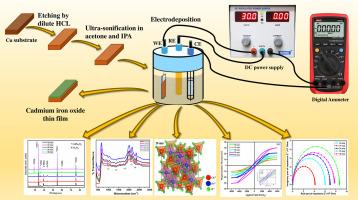In-situ oxidation time dependent low-cost synthesis of cadmium iron oxide thin films for electronic and spintronic devices
IF 5.7
3区 材料科学
Q2 MATERIALS SCIENCE, MULTIDISCIPLINARY
引用次数: 0
Abstract
Cadmium iron oxide (CdFe₂O₄) thin films were synthesized via electrodeposition. Five films were prepared with oxidation times ranging from 10 to 30 min to investigate the influence of oxidation time on their properties. X-ray diffraction revealed a well-ordered single-phase spinel structure, with crystallite size reaching 45.01 nm at an oxidation time of 25 min. Phase purity improved with increasing oxidation time, with optimal results at 25 min. FTIR spectra confirmed the spinel structure through two distinct absorption bands below 1000 cm⁻¹. SEM analysis showed interconnected cuboidal and polyhedral grains averaging 147.25 nm, consistent with early-stage grain growth. The 25 min oxidized film exhibited superior multifunctional performance, with a dielectric constant of 25.63 at 1 MHz, a maximum saturation magnetization of 30.27 emu/cm³, and coercivity of 654.28 Oe. These results highlight the potential of electrodeposited cadmium iron oxide thin films for integration into MRAM and electric-field-controlled magnetoelectric random-access memory (MeRAM) devices.

用于电子和自旋电子器件的镉氧化铁薄膜的原位氧化时间依赖性低成本合成
采用电沉积法合成了四氧化二铁镉(CdFe₂O₄)薄膜。制备了5种氧化时间为10 ~ 30min的膜,考察了氧化时间对膜性能的影响。x射线衍射结果显示,氧化时间为25 min时,晶粒尺寸达到45.01 nm,为有序的单相尖晶石结构。相纯度随氧化时间的增加而提高,在25 min时达到最佳效果。FTIR光谱通过1000 cm以下的两个不同的吸收带证实了尖晶石结构。扫描电镜分析显示,晶粒呈立方体和多面体相互连接,平均为147.25 nm,与晶粒早期生长一致。25 min氧化膜在1 MHz时的介电常数为25.63,最大饱和磁化强度为30.27 emu/cm³,矫顽力为654.28 Oe,具有优异的多功能性能。这些结果突出了电沉积氧化镉薄膜集成到MRAM和电场控制磁电随机存取存储器(MeRAM)器件中的潜力。
本文章由计算机程序翻译,如有差异,请以英文原文为准。
求助全文
约1分钟内获得全文
求助全文
来源期刊

Materials Research Bulletin
工程技术-材料科学:综合
CiteScore
9.80
自引率
5.60%
发文量
372
审稿时长
42 days
期刊介绍:
Materials Research Bulletin is an international journal reporting high-impact research on processing-structure-property relationships in functional materials and nanomaterials with interesting electronic, magnetic, optical, thermal, mechanical or catalytic properties. Papers purely on thermodynamics or theoretical calculations (e.g., density functional theory) do not fall within the scope of the journal unless they also demonstrate a clear link to physical properties. Topics covered include functional materials (e.g., dielectrics, pyroelectrics, piezoelectrics, ferroelectrics, relaxors, thermoelectrics, etc.); electrochemistry and solid-state ionics (e.g., photovoltaics, batteries, sensors, and fuel cells); nanomaterials, graphene, and nanocomposites; luminescence and photocatalysis; crystal-structure and defect-structure analysis; novel electronics; non-crystalline solids; flexible electronics; protein-material interactions; and polymeric ion-exchange membranes.
 求助内容:
求助内容: 应助结果提醒方式:
应助结果提醒方式:


